SUMMARY
This is AI generated summarization, which may have errors. For context, always refer to the full article.

The Philippine Cities and Municipalities Competitiveness Index of the National Competitiveness Council measures key pillars of competitiveness such as economic dynamism, government efficiency, and infrastructure. It offers a practical and comprehensive assessment of whether our key cities have what it takes to compete for investments and talent.
Of 136 cities included in this survey, Makati ranked 1st in its latest ranking (see Table 1).
Table 1. Competitiveness Ranking of Cities for 2014
|
|
OVER-ALL RANKING |
COMPONENTS |
||
|
Economic Dynamism |
Government Efficiency |
Infrastructure |
||
|
1 |
Makati |
Paranaque |
Naga |
Davao |
|
2 |
Cagayan de Oro |
Makati |
Iloilo |
Cagayan de Oro |
|
3 |
Naga |
Manila |
Angeles |
Marikina |
|
4 |
Davao |
Naga |
Makati |
Makati |
|
5 |
Marikina |
General Santos |
Cagayan de Oro |
Cebu |
|
6 |
Iloilo |
Mandaluyong |
Tagbilaran |
Quezon City |
|
7 |
Cebu |
Valenzuela |
San Fernando |
Iloilo |
|
8 |
Manila |
Caloocan |
La Carlota |
Angeles |
|
9 |
Valenzuela |
Cagayan de Oro |
Baguio |
Pasay |
|
10 |
Paranaque |
Cebu |
Laoag |
Manila |
Source: National Competitiveness Council (2014).
This is part of what puts some weight on the claim by presidential aspirant Jejomar Binay: “Ganito kami sa Makati – kung ano ang ginawa namin sa Makati, ay gagawin namin sa Pilipinas.” He refers not just to Makati’s relative success, but also to the severe lack of development in the rest of the country.
It is tempting to believe his statement – certainly a seductive message for the rest of the country that hungers for the kind of wealth and public services that Makati residents seem to enjoy. Yet, anyone who really understands the role Makati plays in the overall economy and how this ties to this city’s finances would realize that there are issues not worth emulating in this city.
Because of the uneven growth pattern of the country, Makati is one of the cities benefiting from the lion’s share of the country’s economic growth and subsequent tax revenues. This fuels the kind of public spending in that city that is unlikely to be possible in the rest of the country, at least for many years to come.
Some would even say that part of Makati’s spending programs is not really necessary, and perhaps even unfair when taken from a national perspective. Here’s why.
Spending power
Using available official data on public spending and juxtaposing this against the population of key cities so that it’s comparable on a per person basis, figures 1 to 3 illustrate how Makati is easily the biggest spender.
Makati’s total education spending per student is almost 6 times that of Quezon City’s. Its spending per resident on health is roughly 5 times that of Davao City. And its spending per resident on social welfare is twice that of Cagayan de Oro City.
These figures don’t yet provide any indicator on the quality of these services, nor their eventual impact on actual education, health and other social sector outcomes.
In fact, since we scaled by the number of residents, it appears that almost everything is more expensive (or excessively generous) in Makati.
By our rough estimates, if Makati will serve as the “benchmark” for total public spending in these areas for the rest of the country, then the national budget will need to increase by some 40-50%.
Figure 1. Basic education spending per student for selected Philippine cities
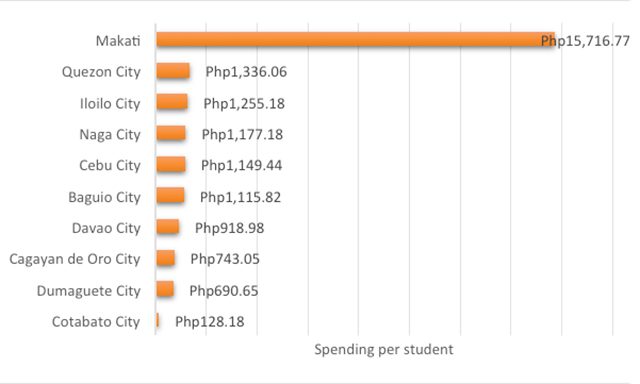
Figure 2. Health spending per capita for selected Philippine cities
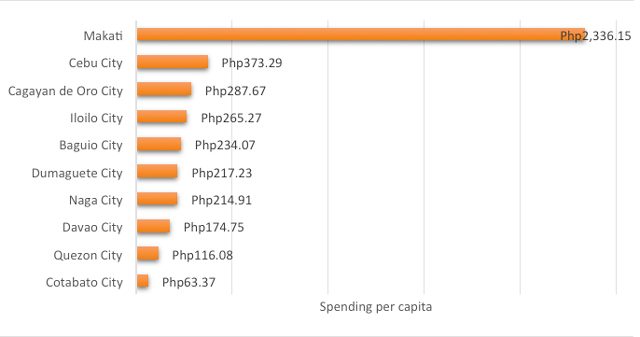
Figure 3. Social welfare spending per capita for selected Philippine cities
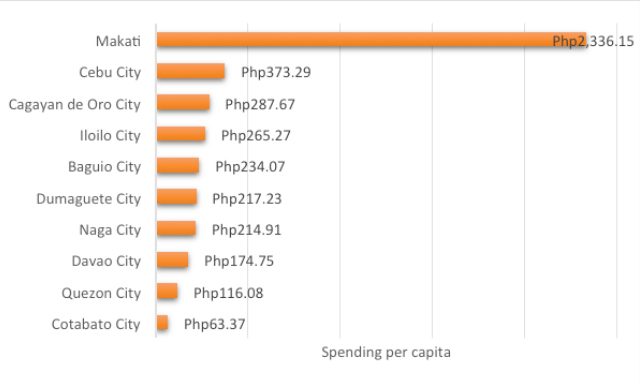
Makati can afford such spending, as figure 4 shows, because its total operating income is well over P9 billion, i.e. the sum of its tax and non-tax revenues, plus transfers from the central government. This is thrice larger than Cebu City’s and twice that of Davao City’s.
In fact, Makati’s operating income is roughly comparable to the combined operating incomes of the cities of Dumaguete, Cotabato, Naga, Baguio, Iloilo, Cagayan de Oro, and Cebu. And while Makati’s operating income is P2 billion less than Quezon City’s, take note that Makati’s population is just one-fifth of Quezon City’s.
Figure 4. Total operating income and population for selected Philippine cities
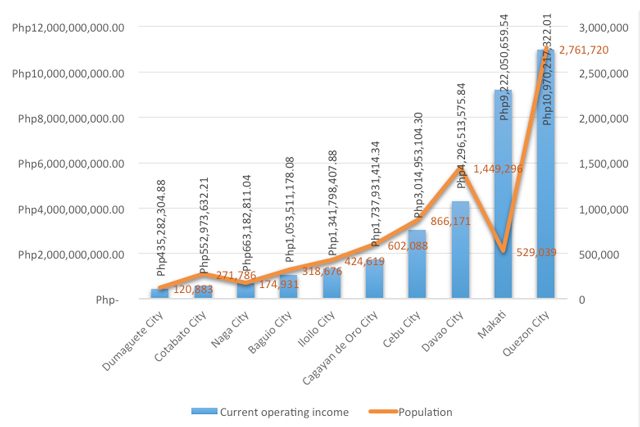
Makati’s advantage
Roughly 80% of Makati’s operating income is sourced from local tax revenues, such as real property taxes and business taxes, while nearly 10% is obtained from local non-tax sources.
Hence, the city is far less reliant on the Internal Revenue Allotment (IRA) (i.e. transfers from central government to help meet necessary local expenditures) unlike the other highly urbanized cities across the country.
Makati’s strong financial position, in turn, is directly linked to the concentration of wealth in this city.
Just to illustrate: a typical house in Makati’s posh Forbes Park costing around P400 million could already generate up to P5 million in real property tax revenues based on our rough calculations. It is unlikely that many other cities will contain such a concentration of expensive properties, when compared to Makati City.
In addition, many corporations operate in the Philippine countryside, but maintain their headquarters in Makati. Just consider the over 700 corporations that constitute the influential Makati Business Club, whose business operations and staff directly contribute to the economic dynamism of Makati City. These are only among some of the businesses fueling the P5 billion in business tax revenues, on average per year, received by Makati in the past six years.
It is fair to say that the uneven economic growth across the Philippines tends to favor Makati City. That the country’s wealthy families and powerful corporations call Makati their home definitely contributes to Makati’s war chest for public spending.
This uneven growth pattern is probably something we should address rather than emulate. Spreading these resources and investments more evenly across the country is likely going to deflate part of Makati’s revenue and spending bubble—now artificially high only because of the uneven economic development in the country.
Seniors’ perks in Makati
There is also the issue of what is really necessary to spend on, given the country’s overall level of development.
Makati’s spending on seniors is a case in point.
For 2015, the Department of Social Welfare and Development (DSWD) allotted close to P6 billion for its social pension allowance for indigent senior citizens, to cover the monthly P500 assistance per indigent senior citizen as mandated by law. Given an estimated 7 million seniors in the country, only 13% of the elderly enjoys this monthly stipend.
However, any senior in Makati holding its “BLU Card” for senior citizens is guaranteed an annual cash gift ranging from P1,000 to P4,000, on top of the national government’s allowance for indigent elders.
The overall budget for Makati’s BLU Card cash gifts amounted to P160 million in 2013.
Figure 5. The Perks of being a Makati senior citizen, 2013
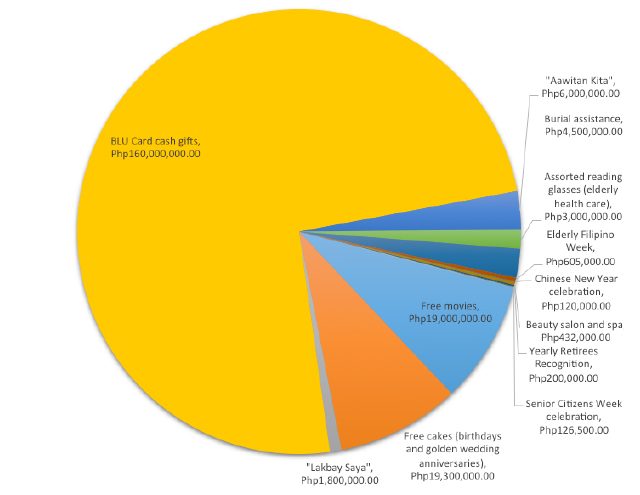
Note: Policy Center staff computations using data from the Makati City Government website. The figures represent budget allocation for the year 2013.
Makati further tops off its BLU card program by throwing in free movies, leisure tours around the provinces called “Lakbay Saya,” annual cash incentives depending on the age bracket, assorted reading glasses for elderly health care, burial assistance to relatives at PHP 3,000.00 each, Elderly Filipino Week, Chinese New Year celebration, all-around salon service at the Makati Beauty Salon and Spa, coding exemption, “Aawitan Kita” and concerts, Annual Retirees Recognition, Senior Citizens Week celebration, access to the SM Felicidad Sy Elderly Center, and free cakes during birthdays and golden wedding anniversaries.
Let them eat cake?
Perhaps even more to the point, Makati’s program to provide birthday cakes for seniors was budgeted at about P19 million in 2013, costing around P300 per cake. In fact, there were 61,255 “cake beneficiaries” in 2014. Makati’s budget allocation for its cake program was increased further to P22 million in 2015. Other cities can barely provide the standard entitlements for senior citizens.
It is difficult to believe that there aren’t any other important items to spend on, in order to support the needs of our elderly across the entire country and not just in Makati City. In fact, the inequality in the country’s growth seems reflected in the inequality in city revenues, which in turn shows up in the inequality in program spending and scope.
If one is asked about which Philippine city to emulate, perhaps it is better to focus on cities that, in the face of many more challenges, still manage to deliver good and necessary services with far less spending.
Cagayan De Oro’s poor population is 19 times that of Makati’s. Davao City’s poor is about 26 times that of Makati City’s. Yet, Cagayan De Oro and Davao, along with Naga, are among the other cities with strong performance in the country’s City Competitiveness Ranking.
The reality of inequality and poverty in the Philippines involves far more challenges than would be solved by free movies, spa services and cake. In addition, any economist will tell you that there is no such thing as free cake. – Rappler.com
Ron Mendoza is Associate Professor of Economics at the Asian Institute of Management and Executive Director of the AIM Policy Center. Maia Altavas is a research intern at AIM Policy Center. The article represents their views and not necessarily that of AIM.
Add a comment
How does this make you feel?
There are no comments yet. Add your comment to start the conversation.